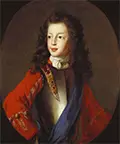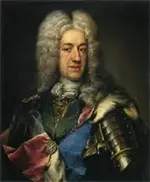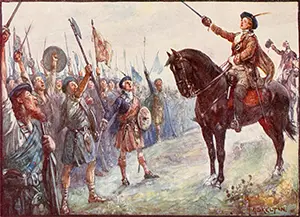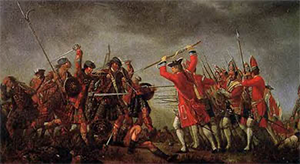Charles Stuart: the 'Old Pretender' and 'Bonnie Prince Charlie'
Charles Stuart, known as the "Young Pretender" and "Bonnie Prince Charlie," lived a lifetime of longing to follow in his grandfather's footsteps and rule as King of England. He never got the chance. 
He was born on Dec. 31, 1720, at Palazoo Muti, in Rome. His father was James Stuart, who by many people's thinking should have succeeded his father, James II on the English throne. Many of the English nobles had other ideas and, in a set of events in 1688 known as the Glorious Revolution, agreed to be ruled by a foreigner, William of Orange, who, with his wife, jointly ruled as <King William III and Queen Mary II. 
The former monarch, James II, having failed in his one attempt to lead an armed invasion of England in 1690, died in 1701. The 13-year-old younger James (left) had himself declared James III of England and James VIII of Scotland. King William III was still firmly in control of England and Scotland, however, and so not even the support of France's Louis XIV, James's cousin, amounted to much in the way of a restoration. James also had recognition of his claim from Spain and from the Vatican, but what he really needed was men and money. He got a number of both at various times during the next two decades, but a variety of factors prevented him from garnering enough support–not to mention a substantial victory over English troops–and he never was able to press his claim effectively enough. His supporters became known as Jacobites, and his attempts to defeat England became known as Jacobite Rebellions. James had married Maria Sobieski, the granddaughter of the Polish king, in 1719. James and Maria had two children, Charles (born in 1720) and Henry (1725). When Charles was born, father and son became known as the "Old Pretender" and the "Young Pretender." Charles grew up in Italy, living in Rome and Bologna. An intelligent child, he could read, speak, and write English, French, and Latin by the time he was 6. He also proved an adept horseman. From a very young age, he had heard stories of his father's attempts to reclaim his birthright. Charles's first real attempt in this regard was at the head of an invasion fleet based in France in 1744. Like so many other invasions before it (the Spanish Armada being perhaps the most well-known example), this fleet was wrecked by storms in the English Channel before it ever got to England. This was not the first time that bad weather had plagued a Jacobite rebellion. In 1719, during the War of the Quadruple Alliance, Spain had sent a number of ships laden with soldiers to Scotland, to support a Jacobite invasion of northern England. A storm prevented all but two ships from reaching shore, and the Spanish invasion force was very small indeed. Undeterred by the weather-plagued naval result, Charles set about planning another invasion. Securing the services of two ships, one a 66-gun man-of-war, Charles sailed to England in July 1745. Again, a storm reared its head. The rest of the invasion fleet never appeared. Charles himself managed to make it ashore with six other supporters. It was a start. He marched to Glenfinnan and raised his father's standard. Word went round The Jacobite force took Carlisle and made it into Derbyshire before they decided to turn back, after hearing of the approach of a large English force under Prince William, Duke of Cumberland. A token victory at the Battle of Falkirk Muir did little but sustain the Jacobite morale. The English force arrived nearby in April 1746. The two sides engaged each other at the Battle of Culloden. The English had superiority all across the board–in men, firepower, and military experience. Charles made a number of mistakes Charles did make one more trip to England, in 1750. He went to London in disguise and converted to Anglicanism. His plan was to reveal his conversion and hope that it would mean more support from people who had previously opposed him on religious grounds. Even that plan came to nothing, and Charles went back to France. Nine years later, with the Seven Years War raging, the French were planning an invasion of England and sought to include Charles in that plan, on the theory that his presence would bring in a number of Scottish and Jacobite supporters. Charles had his own opinions about how to go about things and angered the French foreign minister so much that he told Charles to go away. James Stuart died in 1766. Charles suffered a further indignity when Pope Clement XIII refused to bestow on Charles the title that he had given his father: James III of England James VIII of Scotland. Charles, who had had several children earlier in his life, married in 1772, to Princess Louis of Stolberg-Gedern. They lived in Rome and then Florence. The couple separated in 1780. Charles himself died in 1788, of a stroke. He was 67. |
|
Social Studies for Kids
copyright 2002–2025
David White



 Scotland, and a large number of Jacobites rallied to his cause. Charles and his force marched on Edinburgh, whose leader surrendered. On September 21, the Jacobite force engaged an English army at the Battle of Prestonpans. The result was a stunning Jacobite victory and a further march south, with Charles heading up a force of 6,000 troops.
Scotland, and a large number of Jacobites rallied to his cause. Charles and his force marched on Edinburgh, whose leader surrendered. On September 21, the Jacobite force engaged an English army at the Battle of Prestonpans. The result was a stunning Jacobite victory and a further march south, with Charles heading up a force of 6,000 troops. before and during the battle, and the result was a devastating defeat. Losses on both sides were high, and atrocities were reported by many who fought that day. Charles escaped and led his English pursuers a merry chase through the Scottish moors, aided by a number of Highlanders who had no love for England. He escaped to the Isle of Skye by posing as a maid to a woman named Flora MacDonald, of a clan loyal to the Jacobite cause. A French ship, L'Heureux, eventually rescued him, and he returned to the Continent in September. He never again raised an invasion force.
before and during the battle, and the result was a devastating defeat. Losses on both sides were high, and atrocities were reported by many who fought that day. Charles escaped and led his English pursuers a merry chase through the Scottish moors, aided by a number of Highlanders who had no love for England. He escaped to the Isle of Skye by posing as a maid to a woman named Flora MacDonald, of a clan loyal to the Jacobite cause. A French ship, L'Heureux, eventually rescued him, and he returned to the Continent in September. He never again raised an invasion force.
